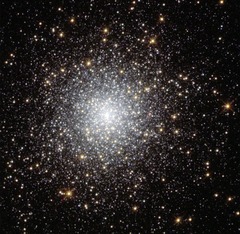
Centaurus is a bright constellation in the southern sky. One of the largest constellations, Centaurus was included among the 48 constellations listed by the 2nd-century astronomer Ptolemy, and it remains one of the 88 modern constellations. In Greek mythology, Centaurus represents a centaur; a creature that is half human, half horse. Notable stars include Alpha Centauri, the nearest star system to the Solar System, its neighbour in the sky Beta Centauri, and V766 Centauri, one of the largest stars yet discovered. The constellation also contains Omega Centauri, the brightest globular cluster as visible from Earth and the largest identified in the Milky Way, possibly a remnant of a dwarf galaxy.

Fornax is a constellation in the southern celestial hemisphere, partly ringed by the celestial river Eridanus. Its name is Latin for furnace. It was named by French astronomer Nicolas Louis de Lacaille in 1756. Fornax is one of the 88 modern constellations.

Hydra is the largest of the 88 modern constellations, measuring 1303 square degrees, and also the longest at over 100 degrees. Its southern end borders Libra and Centaurus and its northern end borders Cancer. It was included among the 48 constellations listed by the 2nd century astronomer Ptolemy. Commonly represented as a water snake, it straddles the celestial equator.

Messier 2 or M2 is a globular cluster in the constellation Aquarius, five degrees north of the star Beta Aquarii. It was discovered by Jean-Dominique Maraldi in 1746, and is one of the largest known globular clusters.

A dwarf galaxy is a small galaxy composed of about 1000 up to several billion stars, as compared to the Milky Way's 200–400 billion stars. The Large Magellanic Cloud, which closely orbits the Milky Way and contains over 30 billion stars, is sometimes classified as a dwarf galaxy; others consider it a full-fledged galaxy. Dwarf galaxies' formation and activity are thought to be heavily influenced by interactions with larger galaxies. Astronomers identify numerous types of dwarf galaxies, based on their shape and composition.

Messier 79 is a globular cluster in the southern constellation Lepus. It was discovered by Pierre Méchain in 1780 and is about 42,000 light-years away from Earth and 60,000 light years from the Galactic Center.

NGC 2419 is a globular cluster in the constellation Lynx. It was discovered by William Herschel on December 31, 1788. NGC 2419 is at a distance of about 300,000 light years from the Solar System and at the same distance from the Galactic Center.

The Fornax Dwarf Spheroidal is an elliptical dwarf galaxy in the constellation Fornax that was discovered in 1938 by Harlow Shapley. He discovered it while he was in South Africa on photographic plates taken by the 24 inch (61 cm) Bruce refractor at Boyden Observatory, shortly after he discovered the Sculptor Dwarf Galaxy.

NGC 1427A is an irregular galaxy in the constellation Fornax. Its distance modulus has been estimated using the globular cluster luminosity function to be 31.01 ± 0.21 which is about 52 Mly. It is the brightest dwarf irregular member of the Fornax cluster and is in the foreground of the cluster's central galaxy NGC 1399.
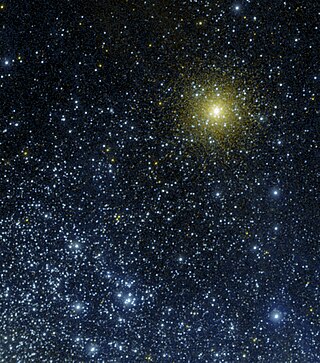
NGC 362 is a globular cluster located in the constellation Tucana in the Southern Hemisphere, slightly north of the Small Magellanic Cloud, to which it is completely unrelated. It was discovered on August 1, 1826 by James Dunlop. It is visible to the naked eye in dark skies, and is an impressive sight in a telescope, although it is somewhat overshadowed by its larger and brighter neighbour 47 Tucanae.
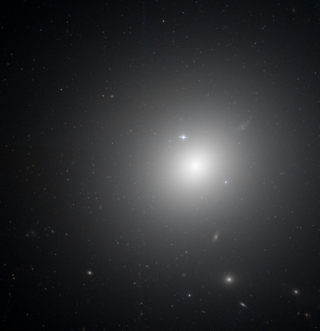
NGC 1399 is a large elliptical galaxy in the Southern constellation Fornax, the central galaxy in the Fornax Cluster. The galaxy is 66 million light-years away from Earth. With a diameter of 130 000 light-years, it is one of the largest galaxies in the Fornax Cluster and slightly larger than the Milky Way. William Herschel discovered this galaxy on October 22, 1835.
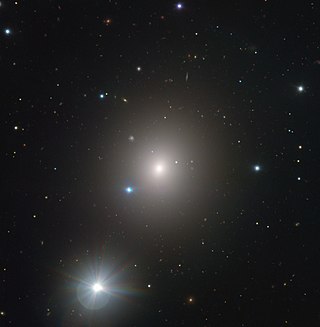
NGC 1404 is an elliptical galaxy in the Southern constellation Eridanus. It was discovered on November 28, 1837, by the astronomer John Herschel. Based on the tip of the red-giant branch distance indicator, it lies at a distance of approximately 60 million light-years from the Milky Way. It is one of the brightest members of the Fornax Cluster.

NGC 5286 is a globular cluster of stars located some 35,900 light years away in the constellation Centaurus. At this distance, the light from the cluster has undergone reddening from interstellar gas and dust equal to E(B – V) = 0.24 magnitude in the UBV photometric system. The cluster lies 4 arc-minutes north of the naked-eye star M Centauri. It was discovered by Scottish astronomer James Dunlop, active in Australia, and listed in his 1827 catalog.

NGC 5634 is a globular cluster in the constellation Virgo (constellation), located about 82,200 light years away. NGC 5634 has an apparent magnitude of about 10 and a diameter of 4 or 5 arcminutes. Its Shapley–Sawyer Concentration Class is IV, meaning the cluster shows intermediate rich concentrations. The star near the upper right is the eleventh-magnitude UCAC2 29844847. There is also a bright orange giant, HD 127119, about 1.3 arcminutes away from the cluster.

NGC 1380 is a lenticular galaxy located in the constellation Fornax. It is located at a distance of circa 60 million light years from Earth, which, given its apparent dimensions, means that NGC 1380 is about 85,000 light years across. It was discovered by James Dunlop on September 2, 1826. It is a member of the Fornax Cluster.

NGC 1381 is a lenticular galaxy located in the constellation Fornax. It is located at a distance of about 60 million light years from Earth, which, given its apparent dimensions, means that NGC 1381 is about 55,000 light years across. It is a member of the Fornax Cluster. NGC 1381 appears edge-on and features a thin disk with high surface brightness and a boxy bulge. Both the box-shaped bulge and the kinematics of the central area of the galaxy suggest that NGC 1381 has a bar.

NGC 1387 is a lenticular galaxy in the constellation Fornax, in the Fornax Cluster. It was discovered by William Herschel on December 25, 1835.

NGC 1374 is a low-luminosity elliptical galaxy in the southern constellation Fornax. It was discovered by John Herschel on November 29, 1837.
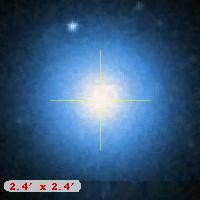
NGC 1379 is a low-luminosity elliptical galaxy in the southern constellation Fornax. It was discovered by William Herschel on December 25, 1835.
